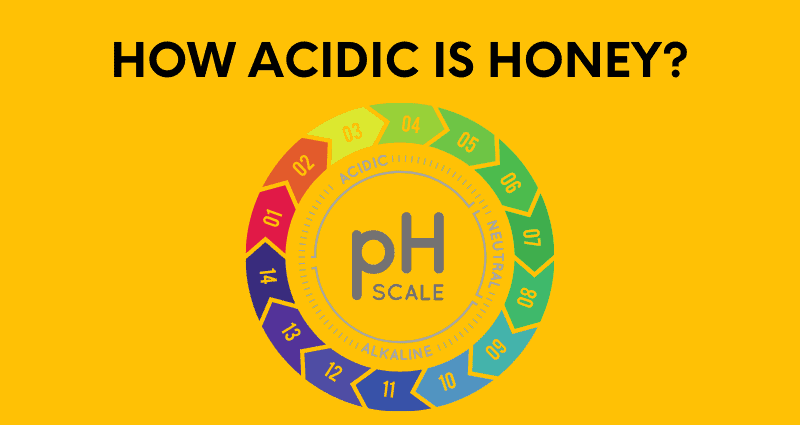Alkaline diets have become popular, which means you may be concerned about the acidity of the food you consume.
Is honey acidic comes up often, so let’s answer it quickly before diving into more detail;
Honey is acidic and has a pH range as low as 3.4 and as high as 6.1 on the pH scale. The pH of honey, on average, is 3.9. What determines the acidity of honey is the floral source from which the bees collect the nectar.
Honey pH In Context
We measure acidity using the pH scale.
The pH scale is logarithmic and runs from 1 to 14. One being very acidic, 7 being neutral, and 14 being basic or alkaline.
Even at its mildest 6.1 pH, honey is an acid. The lower the number, the more the acidity. The higher the number, the stronger the alkalinity.
Most foods we consume are in the pH range of 2-7. Here are some examples:
- Corn – 6.0-6.5
- Cherries – 3.2-4.0
- Oranges – 3.0-4.0
- Lemons – 2.2-2.4
- Eggs – 7.6-8.0
- Carrots – 4.9-5.3
The average pH of honey is 3.9.
What is honey made of?
Honey is a mixture of different types of sugars; It includes fructose, glucose, and sugar. It also falls under the carbohydrate classification but contains many more elements that you should know about.
For more information on what food group honey falls under, click here to read our detailed post.
Part of the honey-making process is the dehydration of nectar. Nectar is generally 70-80 percent water. Honey has a water content of about 18 percent.
Honey contains 26 or 27 amino acids and many enzymes. However, the complete chemical analysis would show you that besides amino acids, honey is a source of:
- Vitamins – such as vitamin C, niacin, and riboflavin are the number one most beneficial aspect of honey, including niacin and riboflavin.
- Minerals – There is a long list of minerals in honey, including iron, zinc, and copper.
- Organic Acids – which help preserve the taste of honey. Not all honey tastes the same.
- Traces of Pollen – Nothing is free, and the bees take the pollen to get the honey.
- Flavor compounds – which come from the flowers and plants the worker bees collect the nectar from
- Fragrance compounds – such as aromatic acids, also come from the flowers the worker bees collect the nectar.
- Antioxidants – This is the second most beneficial part of honey.
- Gluconic acid – is a glucose oxidase – and other acids that come from sugars.
All of these ingredients in honey make raw honey a superfood with some natural antibiotic properties.
Click here to learn more about how bees make honey.
What are the acid types present in honey?
Honey has a long list of naturally occurring acids. They include:
- Acetic acid – the primary acid in vinegar
- Butyric acid – occurs naturally in our bodies thanks to beneficial bacteria.
- Citric acid – such as from citrus fruit, naturally occurs in honey and helps with metabolic processes.
- Formic acid – which is also a defense for ants, helps with chemical synthesis.
- Gluconic acid – is a sugar acid with antiseptic and chelating properties.
- Lactic acid – is helpful as an antimicrobial compound.
- Malic acid – part of the system bodies use to make energy.
- Pyroglutamic acid – part of the amino acids found in honey.
- Succinic acids – help with metabolic function.
- Gluconic acid – helps keep honey sweet.
What is the ph of different types of honey?
As mentioned, honey can range from 3.4-6/1 on the pH scale. What makes honey have such a wide range of pH? The source of honey causes different levels of acidity. For example, when honey bees feed on sunflowers, the pH is 3.7 but when honey bees feed on the flowers from the chestnut tree, their honey has a pH of around 4.53.
When honeybees feed on herbaceous plants, their honey tends to have low pH – 3.50 for rosemary and 3.4 for lavender. However, when bees feed on blossoms, their honey tends to have a pH of around 4/1.
How honey’s acidity kills bacteria
Bacteria have specific environmental ranges in which they can thrive. Low acids are an environment in which many bacteria cannot survive. Another way that honey kills bacteria and other microorganisms are that it dehydrates them.
We’ve talked about how much water is in nectar (70-80 percent.) Honey has a water content of just 18 percent, making it dryer than nectar. When bacteria are in honey, they die because the honey causes them to dehydrate. For that reason, honey has antibacterial properties and is sometimes used to treat surface wounds.
Is honey good for acid reflux?
Several research studies indicate that honey is helpful as a treatment for acid reflux.
A standard homeopathic option is to mix honey and lemon juice in warm water. Even though both lemon juice and honey are acids, the combination creates an alkaline effect that can neutralize stomach acid and heartburn.
How to use honey for acid reflux?
Honey will neutralize the stomach acid by mixing it with lemon juice and warm water.
Another way that honey helps with acid reflux is as a coating for the digestive lining of the esophagus and stomach. The honey coating protects the smooth lining of the upper digestive tract from the harsher stomach acid.
What’s more, honey has other health benefits including relief from peptic ulcers and diarrhea.
What about the beeswax in raw honeycomb?
Great question! We wrote an entire post about what raw honeycomb is made of, the nutritional information, and 8 great ways to eat raw honeycomb. Check it out here.

